
To: Dick Manuel
From: Bob Forsman
Date: 25 Feb 1998
I am 58 years old, retired from Babcock & Wilcox Co., and have been sailing since 1969 - - mostly Snipes at the district and national level. I had a Morgan 25 during the early 1980s, but sold it when I went to Maine for 4 years. Retired after that and began looking for what type of boat I wanted. It was the old "look for 2 years and be ready to close in 2 hours!"
In my search, I had looked at other Seawind IIs, one of which was up for sale in Clearwater, FL (Irish Rose - 031K). Then I stumbled onto 027K through an ad in the Atlanta newspaper. My inquiry revealed that it was a mile and a half from my home on Lake Lanier outside of Atlanta.
As best I can determine, the boat had been owned by someone named Ziefferman. The "how and why" that led Mr. Ziefferman to take a Seawind II to Lake Lanier remains a tale to be told another time, perhaps. But back to the story: In February 1996 we had an unusually long cold spell, with temperatures below freezing for 7 days. Apparently, the raw water in the intake line for engine cooling froze, cracking the strainer sight glass. The intake sea cock was open, and when the weather warmed up well, you know the rest of the story! No automatic bilge pump with float switch, so down she went.
Parts of Lake Lanier's shoreline drop off steeply to significant depths. In talking to the recovery diver, he mentioned that the keel was sitting on the bottom, 110 feet down. The difficult part of the recovery was that the boat had slid down under a 3-foot diameter oak tree on the bottom of the lake. The tree had to be "cut down & moved" in order to safely float the boat to the surface! The boat was under water some 7 days, most of that time being spent in cutting the old oak tree in 100+ feet of water.
Well, the boat was recovered, cleaned-up, and the engine made operable after rebuilding the starter, alternator and injectors. Needless to say, it was sold far below market prices I understand that the asking price on the bottom was $12,000, and recovery costs were just under $10,000. The buyer, Jim O'Neil, replaced cushions & covers, sail covers 30 amp battery charger and bimini. While the boat was out of the water, the hull was checked and the bottom repainted.
At this point, I showed up. It was August 1996. The boat obviously had not been cared for, mechanically, for some time. A lot of work was needed and O'Neil was not prepared to spend the time and money required to fix her up properly. But I, being retired, saw a good project near my home - - and the boat was me! I made a low-down offer which was accepted, and she was mine.
My first order of business was to install a float switch for the bilge pump. Shortly after, the original owner stopped by and offered me the dodger, a full set of cockpit cushions, sun awnings fore & aft with all necessary tubing, and a bunch of other stuff. Of course, I accepted.
I completely removed everything possible from the inside, and stripped, sanded and refinished with an Interlux 60 rubbed finish. The cabin sole was so black that I didn't know it was striped/scored until I removed all the old varnish, oil and dirt. Everything had to be refinished or painted to remove the diesel smell. For the areas not readily visible, and in the engine compartment, etc., I used Sears Weather-beater paint which is mildew-resistant.
Just about everything I checked was bad, loose, or improper. For example, zinc taps on the cooling water heat exchanger and oil cooler were stripped - - being held in probably with permatex. Both of them fell out, the one on the oil cooler falling out while motoring on the ICW. The problem was noticed when the water rose to the cabin sole level.
The transmission was found to be full of water just a gray "goop" came out. The transmission fluid has been changed twice so far, and will likely be changed again next month. An then there was the windlass - - of course, full of water also.
Other tasks included disassembly of the Shipmate stove for cleaning and replacement of all packing, etc. Interestingly, the 1.5 gallon alcohol tank was totally crushed by water pressure when the boat sank. To deal with this, I filled it full of water, froze it, and it popped out a little. Six weeks of freezing/thawing, freezing/thawing finally rounded it out, and it now works fine for holding 1.5 gallons of alcohol. (I'm considering going to propane, but will do some more cruising before I take on that project.) I use a small, 1-burner butane unit now for coffee and 1-pan meals.
I checked out all the electricals and found that most of the breakers were not operating. Finally got them to function after a fashion. The Datamarine wind, depth, and speed instruments survived. But I have come to the conclusion that I will have to replace the entire electrical panel, and would appreciate advice/suggestions from other Seawind II owners/readers. I have replaced all other electronics, presently having an Apelco VHF model 5160, Garman GPS (45), and Apelco Loran which I shall probably dump in favor of another GPS for a spare.
All water lines and tanks were flushed or replaced. I installed a new hot water tank/heater. My 27 gallon polyethylene water tank under the V-berth continues to leak at the bottom outlet. Several applications of 2-part mixes haven't held. (Advice/suggestions from other owners would be appreciated. Ed. Notes: Could that forward tank have been the 1st step towards a holding tank for lake sailing?) I'd like to keep it, but may have to cut the top off and use it for dry storage.
Sails: Two years before I acquired the boat, a new Schaeffer roller furling headsail rig and new jib were installed. The original mainsail and mizzensail have been replaced by Mack sails of Stuart, FL. I went with 2 sets of reef points on the main, but no reef points on the mizzen. I'm still wondering if I should have had reefing capability for the mizzen, but I guess I won't know until I need it!
I have just purchased material to replace the main and mizzen halyards. The rest of the running rigging seems okay, as do the shrouds, etc.
In June of 1997 I moved the boat to Apollo Beach, FL, on Tampa Bay where she presently resides. I'm an 8-hour drive away, but do mostly 1, 2, or 3-month cruises. Cost of transportation to the new home port was $1,200 plus $250, each, for in and out to make a total of $1,700.
I've since gotten an 8.5-foot Zodiak 260S with a Mariner 2 HP motor. For anchoring, two 200-foot rodes came with the boat along with a 22-foot length of chain and a 22S Danforth. I now have a 33# Bruce, 60 feet of 5/16 chain and 200 feet of line as my main anchor system, with a manual windlass to handle it. The back-up is the 22S Danforth, 22 feet of chain and the other 200 feet of line.
Right now I have about $30,000 in the boat, with everything sitting in Florida. The boat still needs some .... well, a lot of miscellaneous things to be done. I guess the major item will be to get a new electrical panel. Too many times I have had to click switches back and forth on the panel before they work. It's just a matter of time till it gets me into trouble!
For 4 weeks last October-November, I took the boat from Tampa to St. Pete and then thru Lake Okeechobee to Stewart, continuing south from there to Marathon and then back up the west coast to Tampa. It was kind of a "hop-one-day-at-a-time" type of voyage - - no overnighters.
I am planning to leave Tampa in mid-March for Key West and up to Angel Fish Creek, a jump-off for the Bahamas. Then on to Bimini, Grand Bahama, and the Abacos. I expect to do a good bit of diving while there. I want to do the Northern Bahamas this year and the Southern part next year. I may try to catch Cuba, coming or going on this trip.
Do you have any detailed information on cutting an access/inspection port in the shower floor? I think it is something I need to do.*
*Editor's Note: I sent Bob a copy of Tim Buckley's 4/15/96 letter to me describing his project of cutting through the the showerpan and installing an access plate. Also, I sent him a rather detailed description of cutting through the cabin sole in front of the head door for compression pole foot repair and access to shower pan hose connections. Much of this has been mentioned in previous SEAWORDS newsletters, but I can send a set to others who might be concerned.)

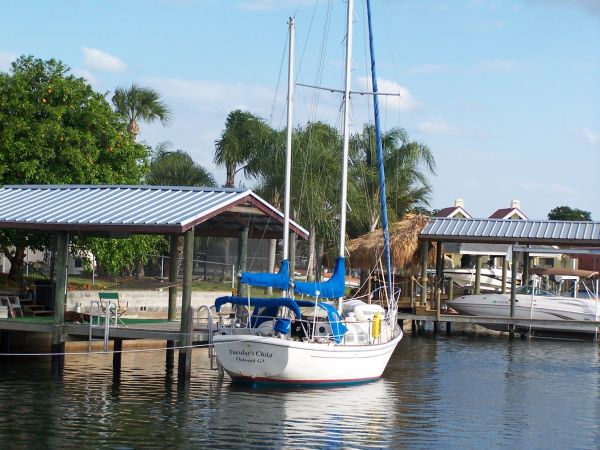
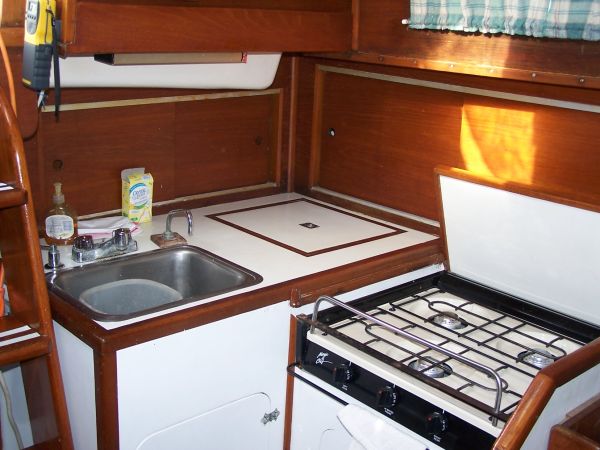
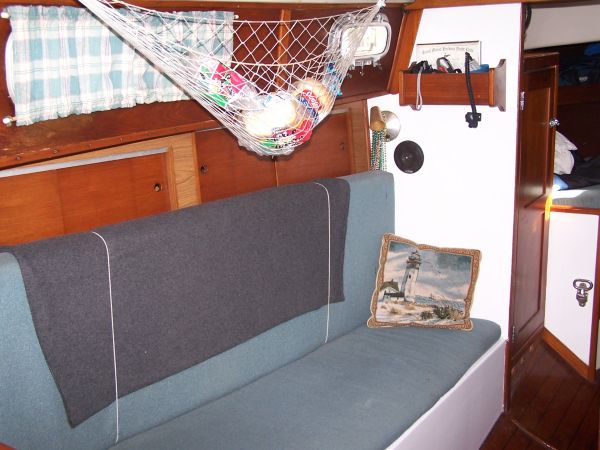

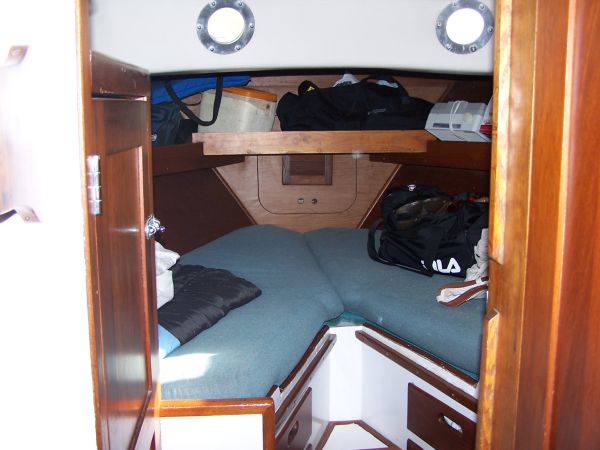
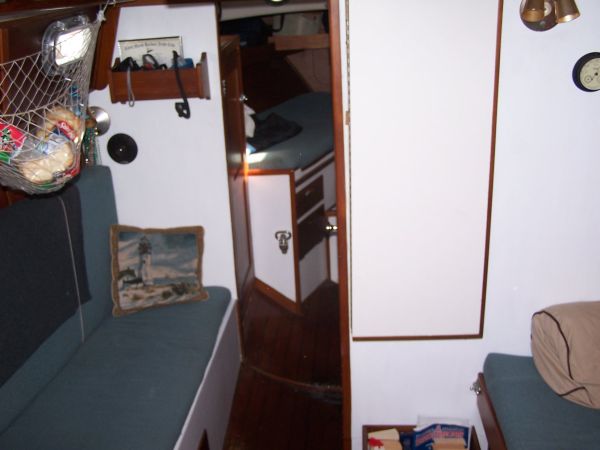

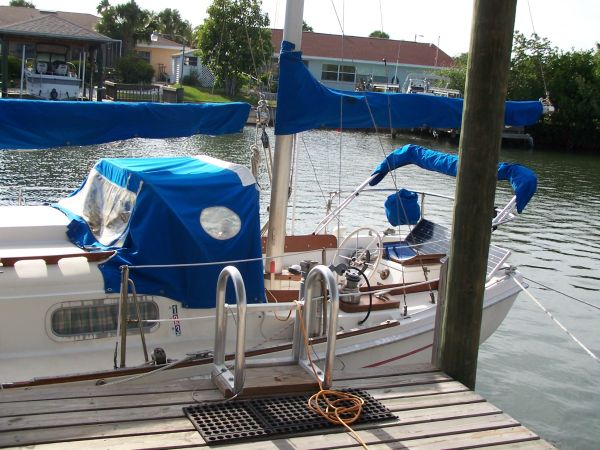
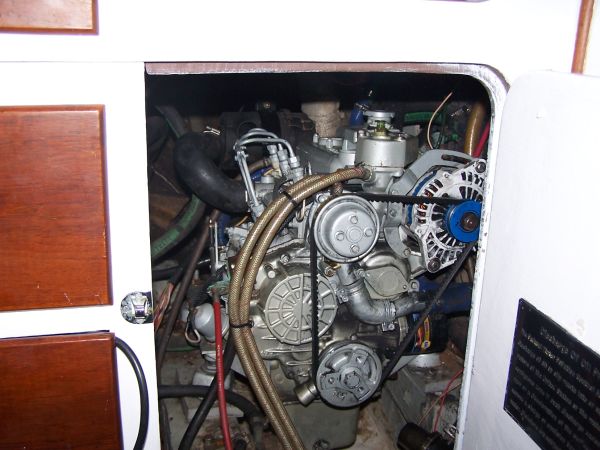
|
Builder/Designer |
|||||||||
|
Builder: Allied Boat Company |
Designer: Tom Gillmer |
||||||||
|
Dimensions |
|||||||||
|
LOA: 32' |
LWL: 25'6" |
Beam: 10'5" |
|||||||
|
Draft: 4'6" |
Bridge Clearance: 43 |
Ballast: 5,800 |
|||||||
|
Engines |
|||||||||
|
Engine(s): Kabuto Diesel |
Engine(s) HP: 28 |
Engine Model: 3-cylinder |
|||||||
|
Hours: 876 |
Cruising Speed: 6 |
Max Speed: 6.7 |
|||||||
|
Tankage |
|||||||||
|
Fuel: 30 gal |
Water: 60 gal |
Holding: 14 gal |
|||||||
|
General This is a blue water yacht built to exceed Lloyd's Of London AAA standards. Standard features include: solid fiberglass construction with end-grain balsa-cored deck and cabin top, all fittings through-deck bolted with back-up plates. The Seawind II, with its long keel and medium displacement, provides maximum directional stability and superior performance on all points of sail, especially to windward. She's fast, even in light airs, stable, and surprisingly stiff. There have been 11 circumnavigations to date, beginning with the first fiberglass boat to ever go around the world, "Apogee" in the early 60's. |
|
|
|
|
|
|
|
|
|
|
|
|
|
|
|
|
|
|
|
|